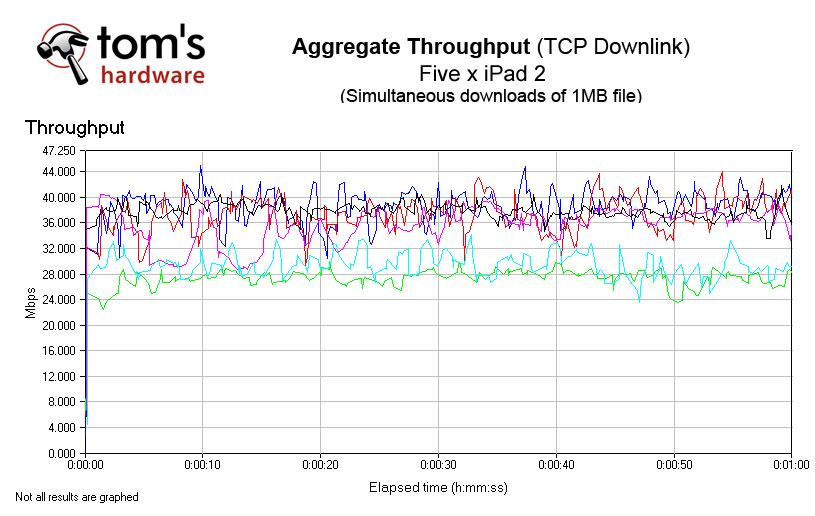Why Your Wi-Fi Sucks And How It Can Be Helped, Part 2
In Part 1, we explained what can go wrong with Wi-Fi signals and how access points can work to improve your wireless performance. It's time for a reality check. We throw six contenders against 65 clients and some hellish interference. Who's left standing?
Five iPad 2s: Single And Aggregate Performance
Now that we know how laptops perform in aggregate, how about the tablets rising up in the market to replace many of them? This is why we brought our assortment of iPads and iPad 2s into the fray.
The bad news with the iPad 2 is that it’s a poky performer. The good news is that it is reliably poky under even terrible conditions. The following images use the same AP color scheme we employed on the prior page. Surprisingly, Cisco turns out to be the laggard of the group at roughly 10 Mb/s, but everyone else packs into that tight 12 to 14 Mb/s band.
If aggregate performance scaled perfectly, we’d see five iPad 2s topping out around 60 Mb/s. Instead, our best-performing APs in this test peak just over 40 Mb/s. Cisco seems to hover around the 28 Mb/s mark.
As we look back, we see that even a mid-range laptop blows the iPad 2 away on Wi-Fi speed, thanks in part to having three antennas instead of one. Maybe this is an unfair comparison because the expected usage for both device types is very different. Still, it’s reasonable to expect that tablets will continue to gain market traction and seek to take on new, more demanding applications as they evolve. Obviously, wireless capabilities in tablets are not keeping pace with processor and graphics improvements, and this needs to change—quickly.
More to the point of this article, having an AP able to make the best of underperforming devices is only going to become more important as we continue to move away from larger systems (desktops and notebooks) into handheld client devices and their scaled-back wireless capabilities. Smartphones have even smaller single antennas than the iPad. And remember from part 1, page 6 how airtime fairness works. If you allow those slow handhelds on your WLAN without airtime fairness implemented at the access point, those devices will significantly drag down the performance of larger, faster systems. Our next page illustrates this dramatically.
Get Tom's Hardware's best news and in-depth reviews, straight to your inbox.
Current page: Five iPad 2s: Single And Aggregate Performance
Prev Page 60 Laptops: Aggregate Performance Next Page Mid-Range, iPads And Laptops Aggregate


